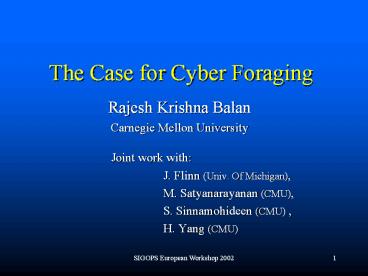The%20Case%20for%20Cyber%20Foraging - PowerPoint PPT Presentation
Title:
The%20Case%20for%20Cyber%20Foraging
Description:
Tactics capture useful remote partitions of application ... Tactics allow us to automatically use extra resources in environment ... – PowerPoint PPT presentation
Number of Views:176
Avg rating:3.0/5.0
Title: The%20Case%20for%20Cyber%20Foraging
1
The Case for Cyber Foraging
- Rajesh Krishna Balan
- Carnegie Mellon University
- Joint work with
- J. Flinn (Univ. Of Michigan),
- M.
Satyanarayanan (CMU), - S.
Sinnamohideen (CMU) , - H. Yang
(CMU)
2
2 Broad class of applications
- Personal Productivity Applications
- Calendar
- Computationally Intensive Interactive
Applications - Speech Recognition
- Language Translation
- Augmented Reality
3
Motivation Handhelds are weak!
Poor performance!
4
Solution Cyber Foraging
- To live off the land
- Use resources in environment to augment device
capabilities by using surrogates - 2 methods
- Data Staging
- Remote Execution
5
The Big Picture
- Data Staging
- Caching of large amounts of data
- Handhelds with limited storage can access this
data fast - Security and authentication
- Remote Execution
- Uses remote servers to augment computational
capabilities of handhelds - Enables computationally intensive applications
- Service Discovery
- Discover servers used by previous two mechanisms
6
Roadmap
- Data Staging
- Remote Execution
- Service Discovery
7
Data Staging Motivation
- End-to-end latency across the Internet isnt
getting better - Physical limits
- Routers, firewalls
- Shows up in interactive file access delays
- Crucial for small to medium files
- Can overcome this by caching prefetching, but
- Handheld clients dont have enough resources
- Cache consistency
- Can untrusted and unmanaged computers help?
- Yes!!
8
Data staging Mechanism
- Coda clients speculatively prefetch data
- Nearby surrogate runs staging server
- Used like a second level cache
- Cache misses serviced by staging server
- Surrogates deployed in high-usage areas
9
Security
- Must provide level of security users expect
- But surrogate is untrusted
- Use end-to-end encryption
- Only store encrypted data on surrogate
- Client caches keys and checksums
- Only need access control for keys
10
Ease of management
- Surrogate is simple to manage and deploy
- No per-client persistent state on surrogate
- Consistency maintained by client
- Minimalistic set of operations
- Uses commodity software (Apache)
- No modifications to base filesystem
- Proxy based approach
- Proxy encapsulates FS specific code
11
The Gory Details
Server
Handheld client
File Server
File System
Normal file traffic
Proxy
Staged file traffic
File keys (via secure channel)
File data
Surrogate
Staging Server
Data Pump
Encrypted file data
12
Benefit for image viewing
Compaq iPaq, 16MB file cache, 60ms latency to
server 3ms latency to surrogate
Data staging reduces cumulative delay up to 64
13
Roadmap
- Data Staging
- Remote Execution
- Service Discovery
14
Motivation mobile interactive applications
- speech recognition, language translation,
augmented reality, - Resource-heavy, but need bounded response time
Columbia U. MARS project
15
Solution Remote Execution
- Augment capabilities of handhelds by using nearby
servers - But how do you make legacy applications use
remote execution? - And get good performance as well?
16
Strawman Solution
- Heavily modify each application to use remote
execution - Tweak every last drop of performance
- Requires 3- 4 grad student months per reasonably
sized application - Grad students have nothing else to do anyway
right?? ? - Method does not scale and is not agile
17
Solution Tactics
- Concise description of applications remote
execution capabilities - Only the useful remote partitions are described
- Can be captured in a compact declarative form
- Allows use of stub generators to ease programming
burden - Tradeoff between code migration and static
partitioning
18
Example Tactic
- APPLICATION pangloss-lite
- / RPC Specifications /
- RPC server_dict (IN string line, OUT string
dict_out) - RPC server_ebmt (IN string line, OUT string
ebmt_out) - RPC server_lm (IN string gloss_out, IN
string dict_out, IN string ebmt_out,
OUT string translation) - / Tactics (Useful Ways to Combine the RPCs) /
- TACTIC dict server_dict
server_lm - TACTIC ebmt server_ebmt server_lm
- TACTIC dict_ebmt (server_dict, server_ebmt)
server_lm
19
Chroma
20
But is it FAST??
- Yes!!
- Tactics capture useful remote partitions of
application - No time spent looking at non-useful partitions
- Performance is comparable to hand-modified
application - Constant overhead added by runtime to best
statically decided case - Overhead is low and reasonable
21
Adjusting to Environment
- Availability of compute servers varies wildly
- Mobility ? Cannot expect just one situation
- Tactics allow us to automatically use extra
resources in environment - Without modifying the application
22
Tactics Using Extra Servers
Still able to get performance improvements with
loaded servers!!
23
Roadmap
- Data Staging
- Remote Execution
- Service Discovery
24
One Ring to Bind Them All?
Cooltown Squirt
uPnP
Jini
SLP
Salutation
- Abundance of service discovery protocols
- Every site has its own favourite
- Mobile applications cannot assume any particular
mechanism - We built a middleware service to
- Leverage existing mechanisms
- Isolate applications from changes in underlying
mechanism
25
Current Work
- Data Staging
- Proxies for other file systems e.g. NFS
- Cache management policies
- Prediction mechanisms
- Remote Execution
- Creation of resource allocation policies
- Adapting software engineering methods to ease
development times
26
Conclusions
- Cyber Foraging is a vision of mobile computing
- Presented two methods of doing it
- Data Staging
- Remote Execution
27
Tactics Dont Hurt
28
Middleware Service (VERSUDS)
- Virtual layer on top of existing service
discovery mechanisms - Supports common functionality
- Provides standard API to applications
- Provides isolation to mobile applications
29
Related Work
- Data Staging
- Oceanstore
- Peer to Peer Systems (FreeNet, Gnutella )
- CDNs (Akamai)
- Remote Execution
- Odyssey, Spectra, Puppeteer, Abacus
- Declarative languages (4GLs, Little languages)
- Corba, Java RMI































